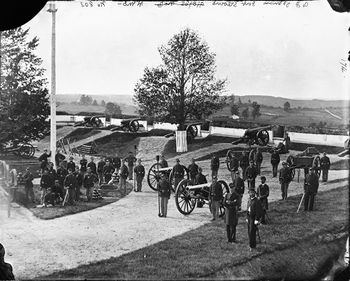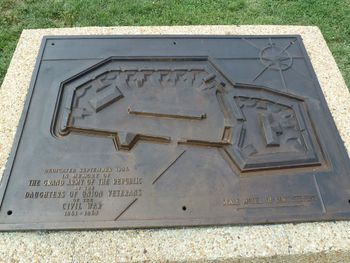Fort Stevens (2)
|
Fort Stevens (2) (1861-1865) - A Union U.S. Civil War earthworks fort built in 1861 as Fort Massachusetts (2) in Northwest Washington DC. It was renamed Fort Stevens after Brigadier General Isaac Ingalls Stevens, who was killed at the Battle of Chantilly, Virginia, 1 Sep 1862. Abandoned after the end of the war in 1865. HistoryOne of the ring of Union fortifications surrounding Washington DC during the U.S. Civil War, see Washington DC Fort Ring. The fort was originally constructed in August 1861 as Fort Pennsylvania with emplacements for 19 guns. The fort was rebuilt in 1863 to strengthen the defense and was then renamed, Fort Stevens. A 17 May 1864 report from the Union Inspector of Artillery noted the following: "Fort Stevens, Lieut. Col. R. C. Benton commanding.–Garrison, two companies Eleventh Vermont Volunteers (First Vermont Heavy Artillery), one company New Hampshire Heavy Artillery (unattached)–1 lieutenant-colonel, 14 commissioned officers, 1 ordnance-sergeant, 423 men. Armament, four 24-pounder barbettes, six 24-pounder siege, two 8-inch siege howitzers, one Coehorn mortar, one 10-inch mortar, and five 30-pounder Parrotts. Magazines, two; dry and in good order. Ammunition, full supply, and in good order. Implements are complete and in good order. Drill in artillery, fair. Drill in the infantry, fair. Discipline, fair. A garrison of sufficient strength." In the summer of 1864, General Ulysses S. Grant had Confederate General Robert E. Lee in a deathtrap around Richmond and Petersburg. General Lee decided to send General Jubal Early with about 20,000 troops to strike at Washington, which his spies had reported was poorly defended. On June 12, General Early started his march from behind Petersburg, and by July 9, he was at Frederick, Maryland, where he demanded and received $200,000 to spare the city. On the same day, General Early defeated Union General Lew Wallace at the Monocacy River. In light of later events, General Wallace's defeat after a stubborn fight became a victory for the Union because he was able to delay Early's advance for a day. On 10 Jul 1864, Early encamped at Rockville, Maryland, 10 miles from Fort Stevens. As a result of the rapid and successful movement of Early, the men of the War Department seemed paralyzed and would give no orders except as they received them from General Grant. General Grant understood the situation and sent the 25th New York Cavalry, which left City Point, Virginia, on July 7 and reached Fort Stevens at midnight on July 10. Also on the 7th, the 1st and 2nd Divisions of the 6th Corps, under General Horatio G. Wright, left City Point. A few hours later General W. H. Emory, with part of the 19th Corps just returning from New Orleans to join Grant, left Fort Monroe for Washington.  By noon 11 Jul 1864, Confederate General Early came in full view of Fort Stevens, reconnoitered the area, and found the fort poorly manned. During the afternoon of that day, General Early tried to find a weak spot in the line but was met everywhere by fort guns and musketry. Supporting Fort Stevens were the guns from Fort De Russy on the left and Fort Slocum (1) on the right. When examining the works at daylight on 12 Jul 1864, Early saw the parapets lined with seasoned troops; he then decided to abandon the idea of capturing Washington but planned to give the Yankees a fight anyway. By nightfall of July 12, the Rebels were sent into full retreat, and the Union Capital had been saved. On 12 Jul 1864, President Abraham Lincoln went to Fort Stevens with his wife and other officers and stood on the parapet calmly watching the battle. The Battle of Fort Stevens was the only battle in which a President was present and under enemy fire while in office. There were 279 Union casualties at Fort Stevens and 40 of the 72 killed were buried in Battleground National Cemetery which President Lincoln dedicated shortly after the battle. Battleground National Cemetery is one of our Nation's smallest national cemeteries. The fort was abandoned in 1865 after the end of the war.
Current StatusIn 1937-1938 the Civilian Conservation Corps partially reconstructed Fort Stevens. The western magazine and gun positions were reconstructed but the eastern lunette was not reconstructed and Emory United Methodist Church buildings occupy it. Period guns and carriages are in place.
See Also: Sources:
Fortification ID:
Visited: 31 Jul 2010
|




